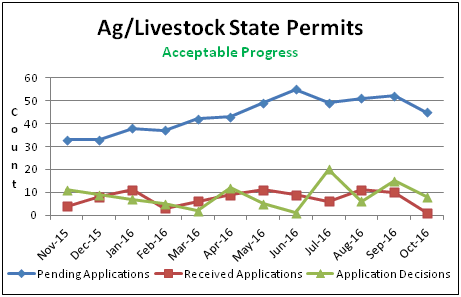October 2016 Metrics Report







Nebraska was one of the first states in the nation to recognize the potential harm of algal blooms. In 2004, NDEQ began monitoring public beaches for the presence of Harmful Algae Blooms (HABs). Also known as Blue Green Algae, HABs are driven by an excess of nutrients, specifically nitrogen and phosphorus. In 2016, 53 beaches were monitored weekly at 50 different lakes across the state from May 1st to September 30th, for the most common algal toxin, microcystin. Lakes that exceed the 20 ppb criteria established by the World Health Organization for recreational waters are closed to full contact recreation for a minimum of two weeks.
To maximize resources, NDEQ has collaborated with seven NRDs, Central Nebraska Department of Health, Nebraska Public Power District, and the United States Corp of Engineers to collect samples. This comprehensive monitoring program could not be accomplished without the assistance of these organizations. The Beach Monitoring Program is focused on protecting the health of people and pets recreating at our state’s public beaches. Direct contact with algal toxins has been linked to health issues such as headaches, coughing, eye irritation, rashes, and gastrointestinal distress. Long term exposure (inhalation) is now being linked to neurodegenerative diseases, such as: ALS, Parkinson’s disease, and Alzheimer’s disease.



Sampling for 2016 indicates a slight upward trend in HABs. A number of factors lead to the increase, the primary factor being the amount of nutrients carried into the lakes. High air and water temperatures and low water levels are also contributors. In 2016, above average air temperatures in June increased lake temperatures much earlier than normal.
NDEQ attempts to work with land owners on a voluntary basis under the non-point source 319 program. NDEQ provides expertise and resources to help the land owner reduce runoff and the corresponding nutrient loading in an effort to reduce HABs.
Emerging Issues/Risks: NDEQ staff have devoted significant time to the following:
NioCorp – the proposed rare earth mining facility proposed for the Elk Creek area. Several meetings have occurred; to date no applications have been received.
Central Nebraska Public Power and Irrigation – Central had a release of hydraulic fluid from Kingsley Dam into Lake Ogallala. Central was not prepared to deal with the incident and NDEQ is working with Central to ensure they are better prepared in the future.
Big Ox Energy – The start-up of Big Ox, a facility that treats South Sioux City wastewater and recovers methane and injects it into a natural gas pipeline, has resulted in unacceptable levels of hydrogen sulfide (H2S) being present in sewer lines, which has impacted several residences. NDEQ is working with Big Ox and city officials on a plan to reduce H2S levels and will continue to monitor the situation.
Accomplishments: On October 13th EPA accepted the Bazile Ground Water Management Plan (GWMP). This is the first nonpoint source GWMP in the nation accepted under the federal Section 319 Nonpoint Source Program. The plan was developed by NDEQ and four NRDs, Lower Elkhorn, Upper Elkhorn, Lewis and Clark and Lower Niobrara. All of these NRDs have jurisdiction in parts of the impacted area. The approval allows project sponsors to apply for federal funding typically available only for surface watershed management projects.
Misc. Items of Note: The Site Review Committee appointed to review the proposed hazardous waste incinerator to be located near Alda at Heritage Disposal and Storage has submitted their final report to NDEQ. The Committee found no issues that had not been adequately addressed by Heritage. NDEQ will forward a package to the Hall County Board upon Heritage submitting their permit application package. Hall County must approve the Heritage proposal before NDEQ begins a technical review of the application.
LB 1101, passed in the last session, requires NDEQ to conduct a study of solid waste management programs. Included in the bill is a requirement for the Director to appoint an advisory committee to provide related assistance. The committee met for the first time October 27th in Kearney.